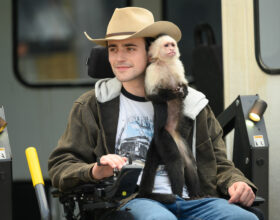True to form, the otherworldliness of Dennis Villeneuve’s (Arrival, Sicario) and Ridley Scott’s neo-noir sequel Blade Runner 2049 pays homage to the original 1982 cult-classic blockbuster Blade Runner, as the visual and audio experience is even more evocative, invasive, and unsettling than the first, serving to purposefully draw the viewer into the action around the destitute, claustrophobic reality of the dystopic narrative, where man is the supreme representation of miraculous conceptions in comparison to machines. AI robots once again highlight what is outstanding about being an autonomous creature/creator with a spiritual component and a conscience – ones who are capable of love. Ryan Gosling does not waver in this, but pulls off a fresh and slightly vulnerable performance, balanced with being tough as nails by stepping up to the plate as K., a blade runner who is also the latest version of a replicant, more obedient than the Nexus 6 models from the original film, whom he is tasked with “retiring.” K. subsequently makes a discovery that alters the course of the film and brings back the original blade runner, Deckard, played reminiscently by Harrison Ford.
In keeping with the earlier existential questions Deckard was forced to grapple with, 2049 runs with the idea of personhood through the ability to construct real memories based on experiences. Thus, the narrative is constantly questioning what is true and what is not in its attempt to validate humanity. K’s girlfriend is not even a replicant, but exists one step further, as a hologram. She is no more than an idea and an illusion, but her lack of physical presence makes her no less important to him, recalling that something does exist beyond the concrete. Jared Leto, outfitted to appear like Jesus, plays the AI leader and producer of a race of replicants who is fascinated with Deckard for his ability to “create” in a way that the machines cannot. On the contrary, humans are not programmed by their creator, but are distinct, imperfect, free, and unique, possessing abilities that are metaphysical. In the end, with all the accomplishments of the replicants, one of the few humans in the film is still responsible for the very existence of these machines, as “she” is the memory-maker who gives them an identity. As bleak and dark as this movie appears, there is hope in the idea that not all we have created is bad, and in fact perhaps our very science, though possessing great potential for evil, is the thing that can lead us into a restorative relationship with our maker, after all. It is here that Gosling delivers best as the surprisingly Christ-like archetype who is able to reconcile man to creator through restoration and sacrifice. This film will not be awarded the Dove-Approved Seal due to the use of profanity in the form of a few F-bombs, as well as graphic violence, resulting in murder, and frequent nudity. However, this movie is an aesthetic masterpiece and advances a narrative that is thought provoking and ultimately redemptive.
Subscribe Lorem Ipsum





